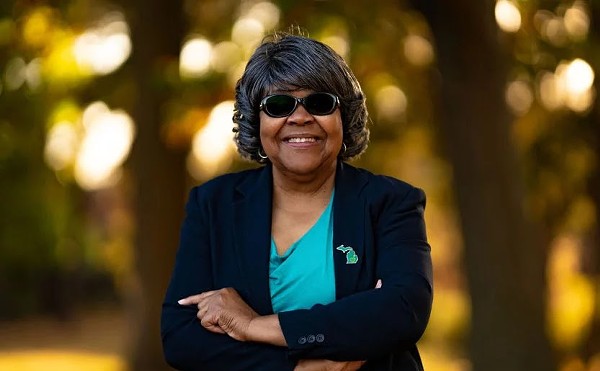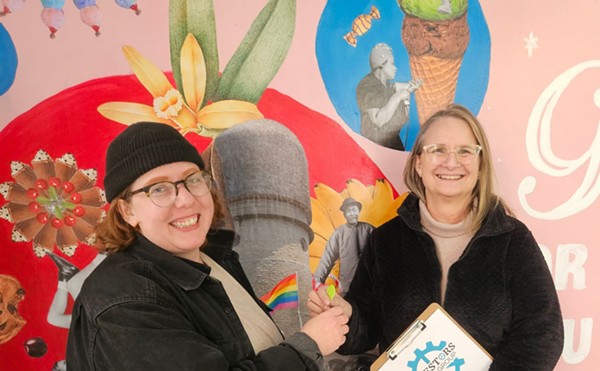Before the prosecution wrapped up its case, it called FBI agent Paul George, who testified for about three days. He said that it was the first time in his career that he had testified in open court.
George, who has been with the FBI since 1983, served as the government’s expert witness on "tradecraft," operational methods used by covert organizations, including terrorist groups. He also testified about a videotape that was confiscated during the raid of the Detroit apartment where three of the defendants lived.
George was the supervisor of the agents who investigated the four defendants, who are accused of providing substantial aid to terrorists. If convicted, Karim Koubriti, 24, Ahmed Hannan, 34, Farouk Ali-Haimoud, 22, and Abdel-Ilah Elmardoudi, 36, each face up to 25 years in prison. The four are also charged with possessing false documents.
Attorneys for the defendants implied that George’s career hinges on the conviction of the four, since he supervised the investigation.
The defense also pointed out that George attended the trial daily, thereby allowing him to tailor his testimony to bolster the prosecution’s allegations.
U.S. District Court Judge Gerald E. Rosen, who is presiding over the case, asked one of the most important questions of the trial: Why did the government’s star witness, Yousseff Hmimssa, who was involved with the defendants and is a convicted felon, avoid terror charges?
Disneyland
George, who grew up in Pennsylvania, where he attended college and law school, testified that he has been involved in covert operations overseas involving "tradecraft." He would not be specific about the operations, but said that he assumed false identities to carry out missions. George also testified that "all foreign undercover agents" use tradecraft, and that the defendants in this case used tradecraft.
The video confiscated from the defendants’ apartment is part of tradecraft, testified George. Prosecutors did not say who they believe made the tape.
About 90 minutes of the more than two-hour video were shown to the jury. It contained images of young Arab men and women in New York City, Las Vegas and Disneyland.
George testified that the tape was purposely made to look like a tourist video, but is really a way to document targets of attack.
A portion of the tape shows an underground entrance to a ride at Disneyland. George said the underground entrance would make a good target.
"There is no better location than underground," said George, who visited Disneyland before the trial began March 28. "That way you maximize exposure to people attacked, and people would panic getting out."
Also on the video was a garbage can, which George said was at the end of the underground entrance. He said the receptacle was an ideal spot to place a bomb, which is why he believes it was included in the video. George said that he checked all the trash bins at Disneyland and that he believed the one on the video was the best one in which to place a bomb.
He admitted on cross-examination that, though he alerted the Disneyland and law enforcement about the defendants’ alleged threat, as of six weeks ago the trash can had not been moved from the area.
Rosen asked George why someone making a tradecraft video would film the faces of those involved. George said this was done to make it appear to be a harmless tourist video if it were discovered by law enforcement officials. He noted that several minutes passed in the video before any faces were shown, which led him to conclude that it was a tradecraft video.
Las Vegas
The video is broken up into several sections, including about 45 minutes of Egyptian television programming. About 10 minutes of footage in Las Vegas elapsed before two young Arab men appeared.
The MGM Grand hotel was shown both at night and during the day.
"It’s important because places can look different at night than they do in the day," said George.
Many hotels appear in the video. The tape contains no footage of downtown Las Vegas. George said the largest population of visitors is not downtown, but in the hotel district.
"An attack there would have significant impact," said George.
Several minutes of a fountain appeared on the film, while a Frank Sinatra song hummed in the background.
As the video played, federal prosecutor Richard Convertino asked George why the video included the fountain.
"The purpose is to deflect what this really is," said George. "In my experience, I took video like this. You must act like a tourist."
New York
In a video clip of a hotel room in New York City, young Arab men and women chatted and laughed as they listened to American pop music on a boom box. The young men, who appeared no older than 22, held up a Nike tennis shoe. Several of them jumped up and down on hotel mattresses. The woman danced and sang. George testified that their actions were staged.
The camera panned briefly outside the hotel room to the New York Times building. George said this shot was intended to document the entrance to the building.
Another image showed a lobby security guard.
"This is an important shot," says George. "I say this is an important shot because the greatest threat is a person in the lobby, the security."
George pointed out that the security guard was armed.
Rosen’s questions
George said the videotape corroborated testimony of the government’s star witness, Yousseff Hmimssa. Hmimssa, an illegal immigrant and self-proclaimed "scam artist," lived with the defendants for about a month. He testified that the defendants spoke of Stinger missiles and jihad, and tried to recruit him into their terror cell.
The defense contends that Hmimssa, who avoided terrorism charges by cooperating with the government, would say anything to save himself. He pleaded guilty to charges of credit card fraud and document fraud in three states. Under his plea agreement, he will serve 37 to 46 months. But the prosecutor could recommend that it be reduced based on his trial testimony. A sentence reduction is subject to Rosen’s approval.
George said a day planner notebook found in the apartment where three of the defendants lived is further proof of a terrorist plot.
It contains sketches that the prosecution says depict a U.S. Air Force base in Turkey and a military hospital in Jordan. The defense contends that the day planner belonged to a mentally ill Yemeni man who had delusions of being a general.
Defense attorney Leroy Soles pointed out that George has never published anything on tradecraft, making it impossible for the defense to test his expertise.
"You can say whatever you want on tradecraft?" said Soles. "You can make stories up? You can adapt your testimony to the facts of the case?"
But it was the judge who asked the final questions of George.
"In the course of your investigation did you ever consider that Mr. Hmimssa may be involved in terrorist activity?" Rosen asked George.
George said that agents originally did include Hmimssa in the terrorist investigation, but eventually ruled him out.
Asked why he was ruled out, George said that investigators verified some of his accusations about the defendants with the day planner, the video and other evidence.
"It doesn’t rule him out," said Rosen. "It rules others in."
The judge’s final question was how George determined that Hmimssa was not involved in terrorist activity.
"I saw no indication that he ever was involved," said George. "I can’t prove a negative." Ann Mullen is a Metro Times staff writer. She can be reached at 313-202-8015 or [email protected]





